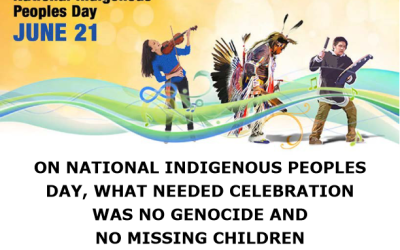The recent history of the Innu, formerly of Davis Inlet, is a classic demonstration of a cosmic law for aboriginal Canadians. Too much money intended to help people is disappearing into huge black holes. Who in the Department of Indian and Northern Affairs Canada (INAC) is watching out for your tax dollars? Why has so much been spent for the Innu and so little accomplished?
In 1967 hundreds of Innu were forced to relocate to Davis Inlet from scattered settlements in Labrador. Over time, governments have refused responsibility for the relocation, but it definitely qualified as aggressive, if well-intended social engineering. On this uninhabitable island, finding their traditional food sources of meat and fish was a lost cause for most of the year due to freeze-up conditions.

Economic opportunities were few, and survival on social assistance appeared to be the norm. Band leaders appeared mostly dysfunctional and totally unable to deal with their people’s problems. This ersatz community soon descended into social chaos. We have all seen the television images of Innu children, some as young as five, sniffing gasoline and the pictures of widespread community abuse of alcohol coming out of Davis Inlet.
Finally in 1993, after much campaigning, the Innu convinced the government of the day to relocate them to a better place. An agreement to that effect was fast-tracked in 1996. INAC and Newfoundland reached a $350 million agreement to build a new town. A total of 133 new homes were built, as well as a sewer system, roads, stores, a hotel, a fire hall, a nursing station, a police services building, a school and every sort of infrastructure a new community requires.
Ottawa saw this as a first step in its Labrador Innu Comprehensive Healing Strategy to stabilize health, create safer communities and help the Innu to build a better future. In 2000 the feds offered another healing gesture, to bring the Innu into the Indian Act, to rectify an omission when Newfoundland joined Confederation in 1949. “The Innu are a proud people who want the authority to make decisions that affect their community and the lives of their people,” said one official at the time.
The new community, a place named Natuashish a mere 15 kilometers west of Davis Inlet, started to welcome the Innu in 2002. The group now also had an agreement with Inco that directed millions of dollars in resource revenues from Voisey Bay into a trust fund for them. Last year Ottawa contributed $10 million to the Innu, more than $50,000 for a family of five. Things were looking up.
But the money never made it through the pipeline. Petitions from the Innu now allege that Inco’s payments to the band have disappeared; the charges cite credit card fraud, mysterious bank transfers and missing blank cheques. Here’s the kicker, not an isolated phenomenon on reserves: the petition to Ottawa demands that the Chief be fired. He, of course, has refused to leave. In the meantime, drug dealing, bootlegging and alcohol abuse has increased again to a fevered pitch. At the last band election, booze was widely distributed.
For months, the response from authorities has been the usual non-performance. Newfoundland’s Aboriginal Affairs Minister, Tom Rideout, wanted Ottawa to launch an investigation into the missing funds. INAC Minister Andy Scott said it was up to the RCMP to lay charges upon receipt of a complaint.
That statement is ridiculous and Scott knows it. Many have taken that very route, only to be asked by the RCMP’s commercial crime section, “Will the Chief back you up on this complaint?” Since the chief is often the culprit, of course, the answer is always, “No.” I have witnessed such efforts personally, and the outcome is always the same. “Sorry,” the RCMP replies, “unless the Chief is willing to participate in an investigation, there is nothing we can do.” Case closed.
INAC is spending eight billion dollars a year on First Nations. The funds received by band offices have increased dramatically each year, but things have not improved. In many cases, things have gotten worse. In some, the fortunes of the ones lucky enough to win an election, and their retinues, have spiralled to heights that rival winning a large lottery. But red flags have popped up among everyday native people scattered across Indian country. The money disappears and even those investigations and audits that do proceed take as much as three years to come to unsatisfactory answers.
No one is willing to stand up to correct the problem, and more money is heading down the same hole. The silence from the Grand Chiefs and the National Grand Chief on this issue is the most deafening. Where and when will the people have a voice that will speak for them and protect their interests?


